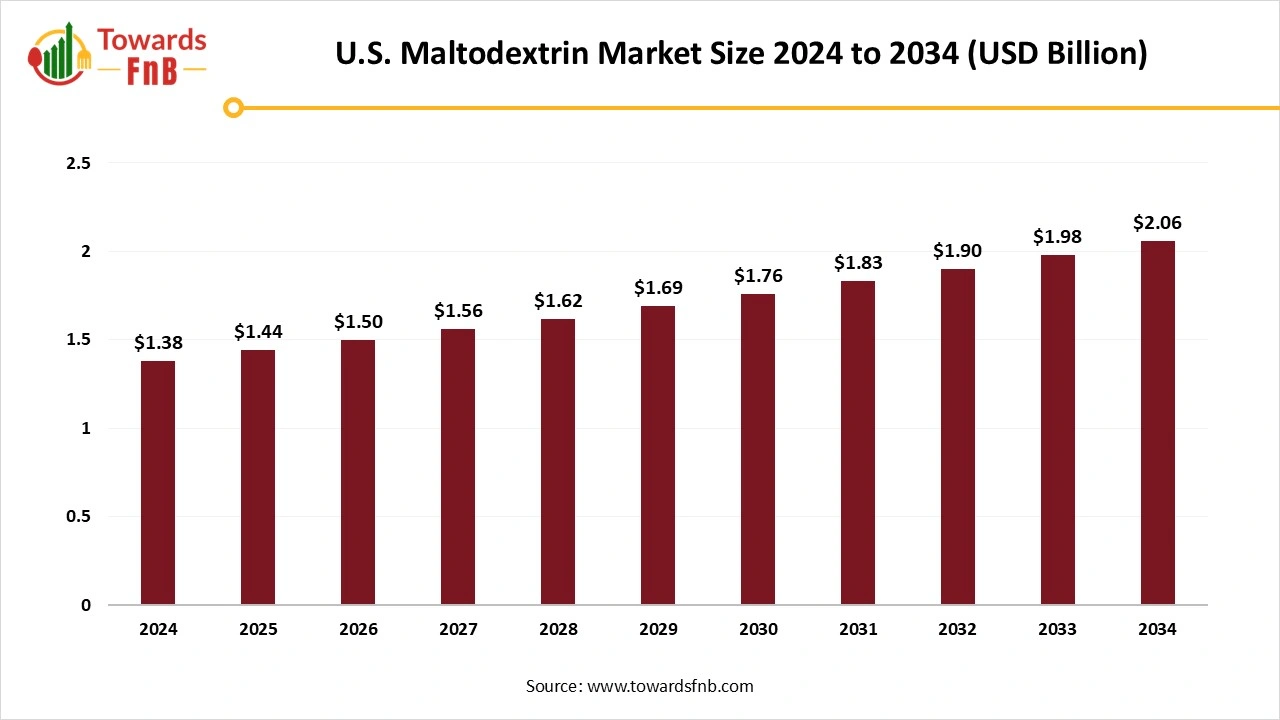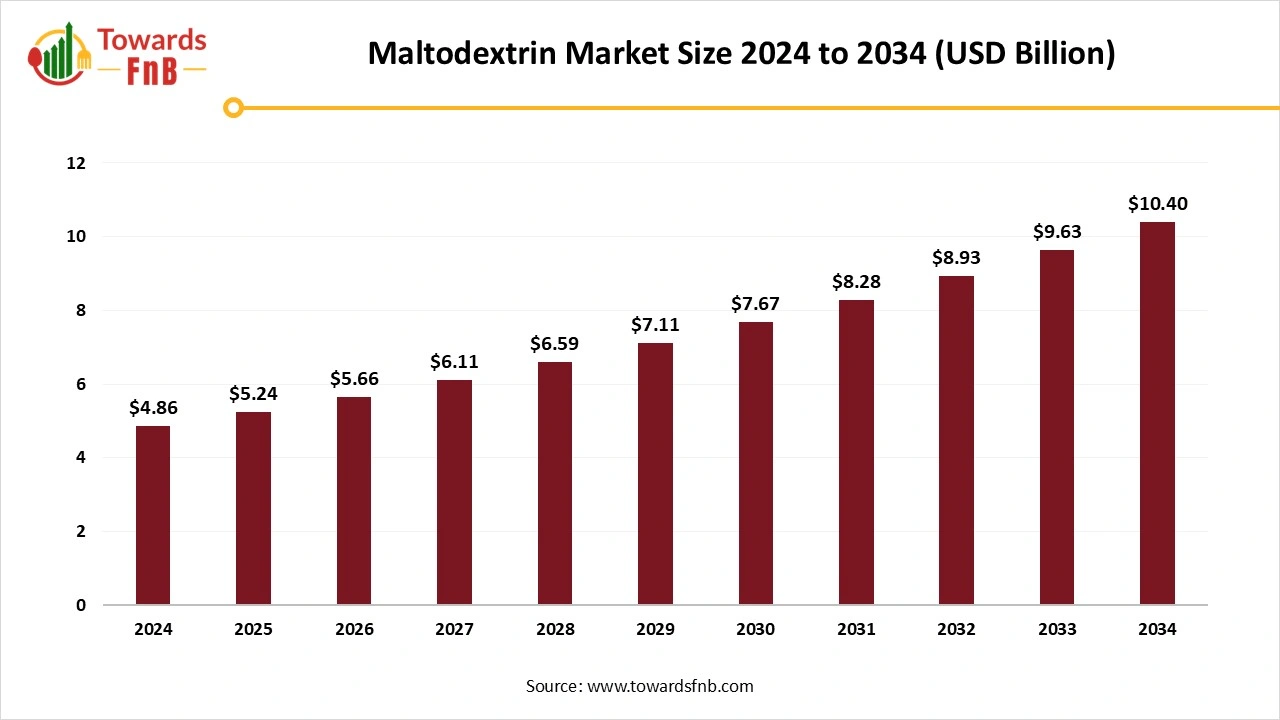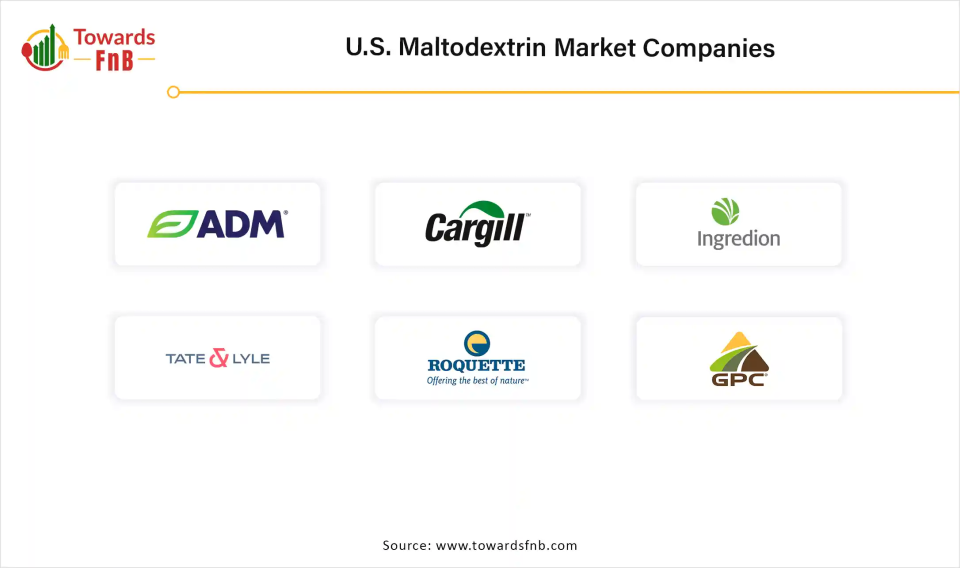December 2025
The U.S. maltodextrin market size was calculated at USD 1.38 billion in 2024 with projections indicating a rise from USD 1.44 billion in 2025 to approximately USD 2.06 billion by 2034, expanding at a CAGR of 4.1% throughout the forecast period from 2025 to 2034. Growing food & beverage, pharmaceutical and cosmetics sector and demand for the organic, gluten-free functional ingredients driving the market.

| Study Coverage | Details |
| Growth Rate from 2025 to 2034 | CAGR of 4.1% |
| Market Size in 2025 | USD 1.44 Billion |
| Market Size in 2026 | USD 1.50 Billion |
| Market Size by 2034 | USD 2.06 Billion |
| Base Year | 2024 |
| Forecast Period | 2025 to 2034 |
The U.S. Maltodextrin Market refers to the domestic industry involved in the production, distribution, and consumption of maltodextrin a polysaccharide derived primarily from starch (typically corn in the U.S.). Maltodextrin is widely used as a food additives, thickener, filler, binder, and preservative in food & beverage, pharmaceuticals, personal care, and industrial applications. Its low cost, easy digestibility, and neutral flavor make it a staple ingredient across industries. Demand is driven by the growth of convenience food, sports nutrition, and clean-label formulations.
The increasing need for maltodextrin in the cosmetics and personal care sectors is anticipated to generate new market prospects soon. It serves as a thickener and stabilizer in cosmetic production. The increasing number of working women and the rise in disposable income among consumers are fueling demand for cosmetics products. Consequently, robust expansion in the cosmetic and personal care sectors is anticipated to benefit market expansion.
A major element hindering the expansion of the U.S. maltodextrin market is the rising awareness and apprehension about its possible health effects. Although maltodextrin is commonly utilized as a food additive because of its functional characteristics, recent research has questioned its impact on human health. Studies suggest that maltodextrin could lead to intestinal inflammation and disturb the balance of gut microbiota.
Maltodextrin, although widely accepted as safe by the U.S. Food and Drug Administration, may lead to side effects, particularly with high or prolonged intake. Possible side effects comprise digestive problems such as gas, bloating, and diarrhea, along with allergic responses, which could appear as skin rashes or intestinal distress.
The United States, the country exported 2,412 shipments of maltodextrin from October 2023 to September 2024. These exports were conducted by 284 United States exporters to 255 buyers, indicating an increase of 83% compared to the previous twelve months. During this time, in September 2024 alone, the United States completed 254 export shipments of Maltodextrin. This represents a 137% increase compared to September 2023, while showing no sequential growth from August 2024. The majority of Maltodextrin exported from the United States is sent to Peru, Colombia, and Ukraine.
The global maltodextrin market was valued at USD 4.86 billion in 2024 and is projected to grow from USD 5.24 billion in 2025 to nearly USD 10.40 billion by 2034, with a CAGR of 7.9% during the forecast period. Maltodextrin formulations are increasingly popular for their ability to enhance energy levels, improve texture, and stabilize formulations, making them attractive to consumers worldwide.

Why Corn Segment Dominated the U.S. Maltodextrin Market in 2024?
Corn segment led the U.S. maltodextrin market in 2024. The United States is the leading producer of corn globally, contributing a large share of total production. In 2023/2024, the United States generated almost 350 million metric tons, accounting for roughly one-third of the worldwide corn output. Corn is an easily accessible and cost-effective raw material for producing maltodextrin, making it the favored option for producers. The elevated starch levels in corn allow for effective extraction and transformation into maltodextrin. The neutral taste of corn-based maltodextrin allows it to be used in various applications without changing the flavor of the product.
Tapioca Segment is Observed to Grow at the Fastest Rate During the Forecast Period.
Tapioca, obtained from cassava roots, serves as a typical source for maltodextrin extraction because of its high starch level and relatively simple processing. Tapioca maltodextrin, also known as malto or maltosec, features a smooth consistency that makes it a perfect fat replacer in sauces and desserts. It is frequently utilized as a plant-based gelatin. Tapioca is inherently gluten-free, and the conversion into maltodextrin maintains this quality, making it appropriate for those with gluten sensitivities.
Which Form of Maltodextrin Dominated the U.S. Maltodextrin Market in 2024?
Powdered maltodextrin segment held the dominating share of U.S. maltodextrin market in 2024. Segment dominance is attributed to its versatility and ease of storage, transport, and application in multiple industries. Powdered maltodextrin can be easily integrated into food and drink items, pharmaceuticals, and industrial uses. As per the U.S. Department of Agriculture, the powdered version has an extended shelf life and is favored for large-scale use, particularly in processed food, snacks, and energy beverages. Its ability to dissolve and improve texture makes it a crucial component in various uses, solidifying its leadership in the maltodextrin industry.
Liquid Maltodextrin Segment is Seen to Grow at a Notable Rate During the Predicted Timeframe.
They do not need a specific process for dissolving powder in water. They are commonly utilized to manage blood sugar levels in individuals with diabetes. They also serve as a great source of soluble fiber, assisting in weight control. Liquid maltodextrin is utilized as a carrier for different industrial enzymes and in the formulation of adhesives and coatings. Its high solubility and ease of application make it suitable for these uses.
Which Application Segment Held the Largest Share of the U.S. Maltodextrin Market in 2024?
Food & beverages segment dominated the market with the largest share in 2024. Growth is fueled by the extensive use of maltodextrin in sauces, dairy products, snacks, confectionery, instant soups, and drinks. Its capacity to improve mouthfeel, increase thickness, and extend shelf life renders it vital for manufacturers. Appreciated for its pure flavor and quick dissolving properties, it’s perfect for powdered beverages, energy items, and low-calorie snacks. Increasing demand for processed and packaged foods, especially in urban and rural markets of developing areas, solidified the sector’s strong dependence on maltodextrin.
Sports & Functional Foods Segment is Expected to Grow at the Fastest Rate in the Market During the Forecast Period.
Maltodextrin is a quickly digestible and fast-acting carbohydrate, making it a crucial component in sports nutrition products. It serves as an immediate energy source without causing stomach issues, which is why numerous athletes choose it for their sports beverages and energy items.
Which End User Dominated U.S. Maltodextrin Market in 2024?
Food & beverage manufacturers segment held the largest share of the market in 2024. In food and beverage sector, the diverse uses of maltodextrin help preserve or inhibit spoilage in food items. It can also be described as flavourless and quickly dissolving, making it an essential component for the mouthfeel and shelf-life of various food items. The capacity to incorporate maltodextrin into various food formulations has entirely established it as the essential ingredient for both large-scale production and small-scale food preparation. Maltodextrin plays a crucial role in food technology, harmonizing flavor, consistency, and nourishment. This ingredient boasts numerous advantages ranging from product stability to consumer contentment, thereby establishing a robust foundation within the framework of the contemporary food industry.
Nutraceutical & Pharma Companies’ Segment is Observed to Grow at the Fastest CAGR During the Forecast Period.
Of all the carriers assessed, Maltodextrin demonstrated a higher drug entrapment efficiency. Moreover, Maltodextrin was identified as safe and non-toxic, exhibiting free-flowing properties, low solubility in the loaded mixture solution, and good water solubility for convenient hydration. The ability to form films and resist high temperatures is utilized in fast-dissolving oral films, making this dosage form convenient for both pediatric and geriatric patients. Maltodextrin serves as a bulking agent, enhancing the texture and mouthfeel of different products. In powdered supplements, it aids in avoiding clumping and guarantees a smooth, uniform blend. This characteristic is especially advantageous in protein powders, meal replacements, and various powdered items.
Which Distribution Channel Held the Dominating Share of the U.S. Maltodextrin Market in 2024?
Direct Sales (B2B) segment held the dominating share of the market in 2024. This is attributed to its capacity to simplify procurement procedures, improve supply chain effectiveness, and provide greater pricing clarity. Manufacturers and consumers in sectors like food and beverage, pharmaceuticals, and personal care are increasingly choosing to obtain maltodextrin directly from producers or official distributors to guarantee reliable product quality and prompt delivery. Furthermore, the increasing digitalization of B2B commerce has continued to speed up the growth of direct sales channels.
Online Retailers Segment is Seen to Grow at a Notable CAGR During the Predicted Timeframe.
Online shops have seen notable growth in recent years, fueled by the rising appeal of e-commerce platforms and the ease they provide. Shoppers can effortlessly explore and buy various fast-dissolving maltodextrin items from their homes, benefiting from the convenience of home delivery. The increasing use of smartphones and internet access, along with the growing inclination towards online shopping, is anticipated to boost the expansion of this segment in the forecast timeframe.
Reebok and Generation Joy
Celsius Holdings, Inc.
Aqualicia® BIO

By Source
By Form
By Application
By End User
By Distribution Channel
The global micronized salt market size is rising from USD 3,145.70 million in 2025 to USD 3,998.08 million by 2034. This projected expansion reflects ...
December 2025
December 2025
December 2025
December 2025